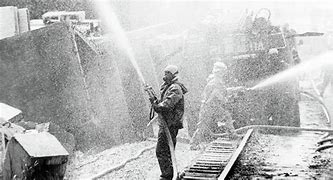Twenty years after the explosion, the cooled magma at the reactor's core 14 meters underground is still a terrible threat.
爆炸事故20年后,在14公尺地底下的反应炉核心冷却岩浆依然构成恐怖威胁。
And will remains so for years to come.
其威胁将持续到未来。
I pray God the sarcophagus never collapses.
我向上帝祈祷,石棺永远不会坍塌。
That would be the worst thing that could happen.
这将是最恐怖的情况。
Because inside, there are 100kg of plutonium.
因为石棺内有100公斤的钸。
One microgram is the lethal dose for a human being.
只需百万分之一公克的钸,就足以致命。
That means there's enough plutonium to poison a hundred million people.
这表示里头的钸足以害死上亿人。
The half-life of plutonium, in other words the time it takes for half of the plutonium to disappear, is 245,000 years.
钸的半衰期,换句话说,要让半数的钸消失需要245000年的时间。

It's something we could thus consider eternal.
因此可以说,它的粒子将恒久存在。
There are areas where there will never be life again...
有些地区从此不会再出现生命......
Despite this terrible warning the nuclear disarmament sparked by Chernobyl is clearly coming into question today.
尽管有严重的警告,切尔诺贝利所启发的裁军行动在今天却成为争论话题。
If nuclear development for civilian uses is being put foryard as a solution to the problems of fossil fuels and global warming,
如果民用核子发展持续进行,以作为核融合与全球暖化现象的解决方案,这片大地提醒着我们,
this landscape reminds us that such an option is not without consequences.
这个选择可能带来的后果。
It requires the greatest caution...and clear information on the real risks it presents.
它需要极度谨慎,并需要明确告知所带来的风险。
Chernobyl also reminds us that if we must live with radioactivity and its unavoidable dangers
切尔诺贝利还提醒了我们,如果我们必须与放射性以及与它带来的必然危险共存,
we also need to spare future generations from any risk of nuclear apocalypse.
我们还须设法让后代免于核子灾变的阴影当中。












